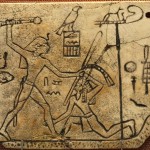
The Origin and Early Development of the Smiting Scene
The depiction of the king with mace raised above a helpless prisoner is one of the most prominent and enduring images of ancient Egypt. Although it has often been claimed that the origin for this iconic image lies in the Predynastic Era, this is unlikely. Not until the Narmer Palette do we see a possible model for dynastic developments of the image. These developments are traced here within the Early Dynastic Period [more…]

The Significance of the Crossed Arms Pose – Part 2: Osiris, The Osiris and the Osirides
Is it a futile activity to ask, as I do in this series of articles, “What is The Significance of the Crossed-Arm Pose?” It might be argued, for instance, that variations in the pose at death exhibited by royal mummies simply reflect what embalmers decided to do on the day, or at least the customary practice of a particular undertaker. Similarly, it might be argued that each individual anthropoid coffin might be expected to reveal some unique design characteristic, and that no significance should be attached to the specific hand/arm pose depicted on the lid. [more…]
 By
By